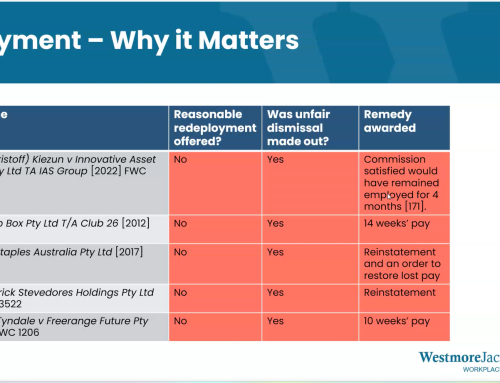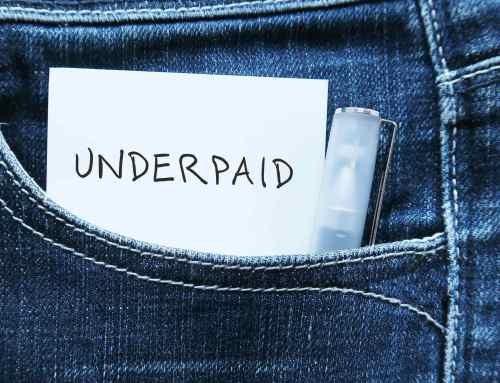
Workplace sexual harassment is a topic which has begun to get its due attention.
This article discusses the circumstances where an employer can be liable for the sexual harassment perpetrated by its employees. It also outlines steps employers can consider taking to reduce their risk of being held liable for the sexual harassment their employees may commit.
What is Sexual Harassment?
Sexual harassment is unwelcome conduct of a sexual nature which a reasonable person would anticipate would make a person feel offended, humiliated or intimidated.
A person can be held to have sexually harassed someone even if they did not intend to sexual harass them. Likewise, a person can sexually harass someone even if they are not sexually attracted to the victim.
It is unlawful, amongst other things, for:
- employees to sexually harass another employee of the same employer, or a person seeking employment with the same employer;
- an employer to sexually harass an employee, or person seeking employment with the employer;
- a person within a workplace to sexually harass another participant (eg. contract worker) of that workplace.
Additionally, it is also unlawful to sexually harass another person in the course of buying or selling goods or services (this could include an employee harassing clients).
Vicarious Liability
Under federal and Victorian law, employers will be liable for the sexual harassment perpetrated by their employees in connection with their employment unless the employer took sufficient steps to prevent the sexual harassment. What amounts to sufficient steps varies between depending on the relevant legislation. Under federal law, employers will be liable unless they took ‘all reasonable steps to prevent the sexual harassment’. Employers will be liable under Victorian law unless they took ‘reasonable precautions to prevent the sexual harassment’.
Courts and tribunals have interpreted these provisions very strictly. It is very rare for a court or tribunal to hold that an employer took sufficient preventative steps and, consequently, is not liable. In 17 of the 18 most recent federal cases where the issue of vicarious liability was considered, the employers were held not to have taken ‘all reasonable steps’ to prevent the harassment.
Near-Perfect Steps? Richardson v Oracle Corporation
This strict approach is typified by the judgement in Richardson v Oracle Corporation
In Richardson, the employer provided employees with a ‘code of ethics’. The code prohibited sexual harassment but did not tell employees it was unlawful. Employees were required to complete online sexual harassment training every two years.
Prior to the incidences of sexual harassment there was no culture of sexual harassment at Oracle. When the sexual harassment occurred, the employer investigated and sanctioned the harasser. The harasser was required to undergo face-to-face equal opportunity training.
Notwithstanding these steps, the employer was found liable. This was because the then Human Rights and Equal Opportunity Commission’s sexual harassment guidelines suggested that employers include in their sexual harassment policies a statement telling employees that:
- sexual harassment is against the law; and
- employers may be liable for the sexual harassment perpetrated by an employee.
Buchanan J held that as Oracle’s code of ethics did not include these “important and easily-included aspects” of the HREOC guidelines, Oracle had not taken all reasonable steps to prevent the harassment. Consequently, Oracle was liable for the harassment perpetrated by its employee.
The One in Eighteen: McAlister v SEQ Aboriginal Corporation
The only case of the 18 most recent federal cases where an employer was found to have taken all reasonable steps was McAlister v SEQ Aboriginal Corporation [2002] FMCA.
In McAlister, the employer was a small community legal centre. One if its employees was accused of sexually harassing clients. The employer was found to not be vicarious liable because it had:
- established a clear complaint-handling process;
- had a senior person inform all employees that sexual harassment would not be tolerated and severe action would be taken against employees who committed sexual harassment; and
- required employees to attend workshops which provided staff with information about sexual harassment.
Additionally, when a complaint was made against the employee who committed the sexual harassment, the employer:
- promptly investigated the complaint;
- issued the employee with a very clear warning that future misconduct would lead to termination of his employment;
- required the employee to have a female co-worker with him when interviewing female clients.
When a second complaint was made against the employee, the employer promptly investigated and dismissed him.
Rimmer FM held that given the employer was a small organisation with limited resources, the above steps were ‘all reasonable steps’. Consequently, the employer was not liable for the sexual harassment committed by its employee.
Tips for avoiding Vicarious Liability
In most cases, a strong sexual harassment policy is the bare minimum for an employer to have any chance at not being vicariously liable for its employees’ harassment. However, a strong policy alone is unlikely to be sufficient.
In addition to a strong policy, employers should ensure they orally communicate their expectations regarding sexual harassment to employees. Employers should enforce the policy and establish a clear complaints-handling system. Regular training and workshops should also be carried out.
Upcoming Briefing
We are pleased to announce that we will be holding another of our Lunchtime Briefings on Wednesday 20 June 2018. This briefing will discuss workplace sexual harassment, with a focus on the legal consequences workplace sexual harassment can have for employers.
Details for the briefing will be sent out shortly. Please email events@westmorejacobs.com.au if you are interested in receiving further information about the briefing.
Adam Colquhoun, Principal
This article is general information only. It is not legal advice. If you need legal advice, please contact us.






Leave A Comment